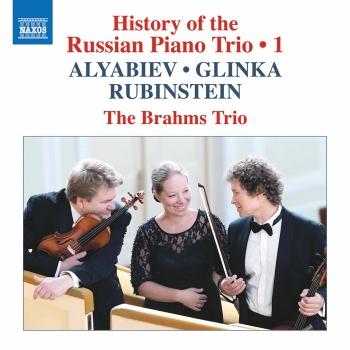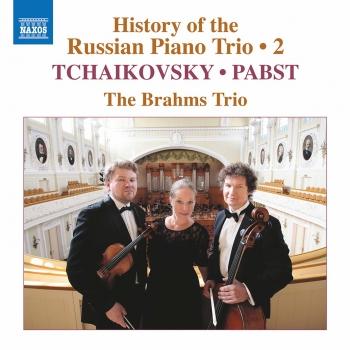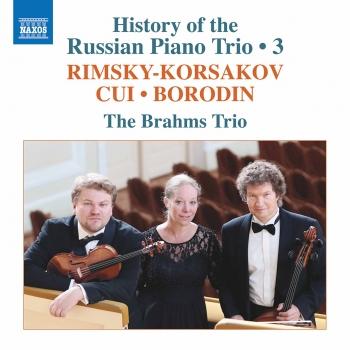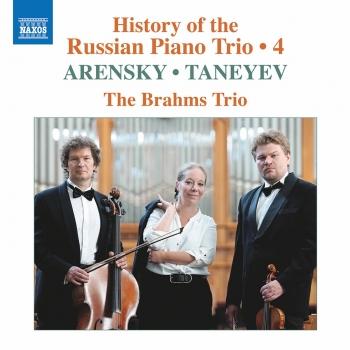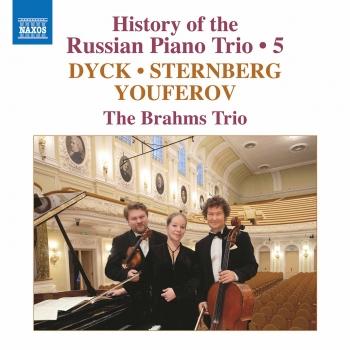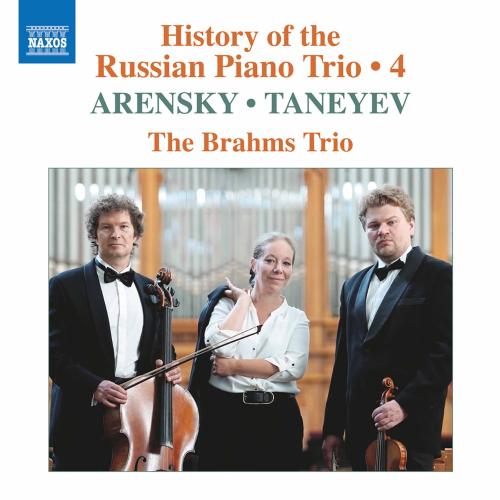
History of the Russian Piano Trio, Vol. 4 Brahms Trio
Album Info
Album Veröffentlichung:
2021
HRA-Veröffentlichung:
14.05.2021
Label: Naxos
Genre: Classical
Subgenre: Chamber Music
Interpret: Brahms Trio
Komponist: Anton Stepanovich Arensky (1861–1906), Sergey Ivanovich Taneyev (1856–1915)
Das Album enthält Albumcover Booklet (PDF)
- Anton Arensky (1861 - 1906): Piano Trio No. 1 in D Minor, Op. 32:
- 1 Arensky: Piano Trio No. 1 in D Minor, Op. 32: I. Allegro moderato 09:57
- 2 Arensky: Piano Trio No. 1 in D Minor, Op. 32: II. Scherzo. Allegro molto 05:40
- 3 Arensky: Piano Trio No. 1 in D Minor, Op. 32: III. Elegia. Adagio 06:24
- 4 Arensky: Piano Trio No. 1 in D Minor, Op. 32: IV. Finale. Allegro non troppo 06:38
- Sergei Taneyev (1856 - 1915): Piano Trio in D Major, Op. 22:
- 5 Taneyev: Piano Trio in D Major, Op. 22: I. Allegro 10:20
- 6 Taneyev: Piano Trio in D Major, Op. 22: II. Allegro molto 12:18
- 7 Taneyev: Piano Trio in D Major, Op. 22: III. Andante espressivo 06:20
- 8 Taneyev: Piano Trio in D Major, Op. 22: IV. Finale. Allegro con brio 11:12
Info zu History of the Russian Piano Trio, Vol. 4
Both Anton Arensky and Sergey Taneyev belong to the generation of Russian composers who came to prominence at the end of the 19th century, midway between Tchaikovsky and Rachmaninov. With its expansive themes and wonderfully elegiac mood, Arensky’s Piano Trio No. 1 is dedicated to the memory of cellist Karl Davydov. The subtle use of counterpoint in Taneyev’s Piano Trio in D major reveals his expertise in combining earlier techniques with the emphatically Romantic style that both composers inherited from Tchaikovsky. These two masterpieces summarise the development of the piano trio genre in Russian music of the 19th century, and subsequently laid the foundations for its further evolution.
"Rich in ‘romanticism’, Anton Arensky wrote two Piano Trios, the first, completed in 1894, is full of memorable melody. The work is in the usual four movements, the mercurial and ‘naughty’ scherzo placed second, the cello is given a gorgeous melody that springs the third movement, while the finale is very energizing. Throughout the Brahms Trio faithfully observe the many dynamic shading. Sergey Taneyev’s Trio came thirteen years later, and at forty minutes was unusual in length at that time. The date of composition was 1907, and marked a return of the composer role as a concert pianist, a fact that probably accounts for the important role he gives to the keyboard in creating the thematic material, the strings often cast in a supporting role in the central movements. Thankfully the pianist here, Natalia Rubinstein, shows restraint, though we can sample her technical brilliance in the finale. Compared with other available recordings, The Brahms Trio offer a superb performance, full of passion, and with spotlessly clean string intonation, while Rubinstein’s nimble fingers weave a wondrous filigree around the strings in the finale. The Moscow Conservatory recording, with its wide dynamic range, is of superb quality. Most strongly recommended." (David’s Review Corner)
Brahms Trio
Brahms Trio
"Brilliant artists who perfectly master all the musical capacities of their instruments, the members of the Brahms Trio also have those rare virtues that are necessary to achieve a real ensemble sound — modesty, flexibility, the desire and ability to hear each other, trust in the voice of the partner. That’s why the Brahms Trio’s performances are creating such incredible emotional power". (Maestro Rudolf Barshai)
Ever since its foundation more than twenty-five years ago, the Brahms Trio has been highly acclaimed for its outstanding artistry, often being called one of Russia’s leading chamber music ensembles. Right at the beginning of its career, in 1993, the Brahms Trio won the International Chamber Music Competition in Trapani, Italy, and in 1995 it was awarded the 1st Prize at the Joseph Joachim Chamber Music Competition in Weimar.
The Brahms Trio’s concert series, featuring chamber works by Brahms, Dvořák, Schubert, Beethoven, and Shostakovich, have gained the trio the highest recognition in hundreds of cities in Russia, Europe, Australia, South Korea, and Turkey. Since 2009, the Brahms Trio has opened every new concert season at the Moscow Conservatory. Critics praise the ‘clarity of the intentions, the singing softness of all three instruments, and a perfectly balanced sound’ (Wiener Zeitung, Austria), the ‘symphonic soundscape combined with the invariable nobleness of tone and the exquisite polyphony of musical texture which is characteristic of chamber music’ (Kultura, Russia).
Russian chamber music is the backbone of the repertoire performed by the Brahms Trio. Recognized as ‘the leading expert on Russian piano trios’ (Music Life Magazine, Russia), the Brahms Trio has performed concert series devoted to Russia’s chamber music heritage at the Tchaikovsky Conservatory in Moscow, the National Philharmonic Hall in Warsaw, the Royal Danish Academy of Music, the Stadtcasino Basel, Seoul Art Centre, and Brussels Town Hall, as well as at festivals in Melbourne, Hong Kong, Istanbul, Vienna, Paris, and London. After the Brahms Trio’s performance of the Trio in A minor by Tchaikovsky at the Brucknerhaus in Linz, Austrian critics wrote: ‘An awesome symphonic opus was represented by the prominent musicians with all the power of the tragic talent and brilliance of sound. [...] A colossal intensity! A masterpiece was born right under the eyes of a stunned audience,’ (Volksblatt, Austria). The Italian newspaper Il Monferrato acclaimed the premieres of the trios by Alyabyev and Pabst: ‘Performed by the Brahms Trio, these opuses, buried for so long in Russian score sheets, are destined for success.’ The Strad Magazine noted: ‘This splendid performance of Shostakovich’s Trio Op. 67, demonstrates irony, bitterness and humour, which are this work’s signature features.’
The premieres of piano trios composed in the Silver Age and the era of Russian Art Nouveau — works that miraculously survived the cataclysms of the 20th century and until recently remained unknown even to professional musicians — were an important part of the Brahms Trio’s missionary and educational project, the ’Russian Chamber Music Assemblies’, from 1998 to 2005 bringing the Brahms Trio to more than 100 cities of even the most remote parts of Siberia, Russia’s northern regions and the Far East. These numerous trips alongside one of the leading events in Moscow’s cultural calendar for two decades, the Art November festival, established by the Brahms Trio in 1994, have made an important contribution to Russia’s cultural renaissance at the turn of the 21st century.
In 2016, after years of research, archival and performing work, in the course of which the unique parts of the Russian cultural heritage were found and presented to the audience, the Brahms Trio compiled a catalogue of chamber music of the 18th, 19th, and 20th century, comprising more than 400 composers and about 1,500 works written by Russian composers in Russia and abroad. The same year the Brahms Trio started recording for the project ‘The History of Russian Piano Trios’, the first anthology of Russian piano trios to be published on CD. The anthology’s first series of five separate releases, focusing on music of the Russian Empire, includes alongside the tops of the chamber music repertoire — the trios of Tchaikovsky, Arensky, and Taneyev — the early works of Alyabyev, Glinka and Rubinstein as well as rare chamber pieces of the great Russian symphonists Rimsky-Korsakov and Borodin. This first set of CDs, that will be released to 2021 by Naxos, also features the world premiere recordings of works which, at different periods and for different reasons, had disappeared from the musical history: the piano trios of Paul Pabst, César Cui, Vladimir Dyck, Konstantin von Sternberg, and Sergei Youferov.
Disciples of the legendary chamber music class of Tatiana Gaidamovich and Alexander Bonduriansky at the Moscow Conservatory, the musicians of the Brahms Trio were acclaimed ‘musical descendants of Vasily Safonov, Leopold Auer, and Karl Davydov’ by The Moscow Times, ‘who have inherited the traditions of the Russian school of music performance and the sublime ideas of ‘cultural missionary outreach’, pioneered by Anton Rubinstein.’
The Brahms Trio was founded by pianist Natalia Rubinstein. Violinist Nikolai Sachenko and cellist Kirill Rodin — both are Winners of the Golden Medal of the International Tchaikovsky Competition (Moscow, 1998 and 1986) — joined the Brahms Trio in 2008. The members of the Brahms Trio are professors of the Moscow Conservatory, recipients of the awards For the Prominent Contribution to the Development of Culture and the title Honoured Artist of Russia.
Booklet für History of the Russian Piano Trio, Vol. 4










